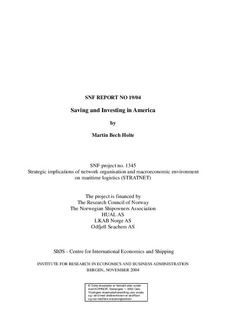Saving and investing in America
Research report

View/
Date
2004-11Metadata
Show full item recordCollections
- Reports (SNF) [542]
Abstract
In this paper we will consider issues relating to the historically low US saving rate and the large current account deficit. The approach is meant to be pedagogical, with an emphasis on clearly illustrating mechanisms behind these developments such that the readers more easily can make up their minds about what the future is likely to bring. The conclusions of the paper are as follows: Even though there are explanations indicating that the US currently should run a current account deficit (see especially Section 4), the tides must eventually turn. Issues relating to long run sustainability make clear that the US trade deficit must eventually be reduced in order to avoid a crisis in the future. This means that the relative price of US produced tradable goods will have to decline, and this will take place through a further depreciation of the US dollar. This depreciation does not have to be especially damaging for the global economy, but this seems to require that East Asian countries collectively allow their currencies to appreciate against the US dollar. A revaluation of the Chinese currency, the Renminbi, is key here. The paper is organized as follows: Section 1 presents the basic data relating to the two intimately releated issues of the US saving rate and current account deficit. In section 2 the relationship between the saving rate and the current account is formalized, and we consider the various ways in which an understanding of the forces behind developments in the current account can be achieved. Section 3 looks more specifically at explanations of the low personal saving rate, and tries to evaluate how critical the situation is. Section 4 considers the effects of global demographic developments on international capital flows.In section 5 we will look at more theoretical approaches to the current account. These give us a clearer understanding of underlying forces behind the current account. Section 6 takes a closer look at requirements for long-run sustainability. Section 7 concludes.
Publisher
SNFSeries
Report2004:19